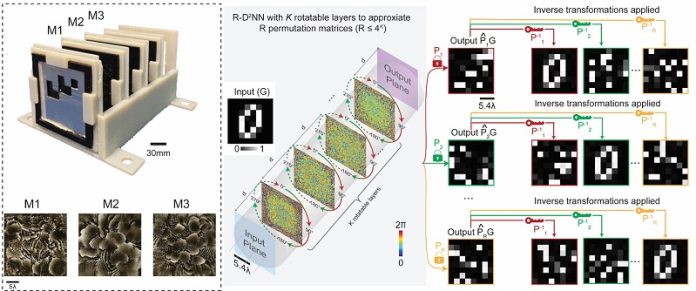
Engineers at the University of California, Los Angeles (UCLA) have made a significant breakthrough in optical computing, unveiling a new method that promises to revolutionize data processing and encryption.
The study, led by Professor Aydogan Ozcan and his team, has been published in the journal Laser & Photonics Reviews.
This innovative research introduces a reconfigurable diffractive optical network capable of performing complex data operations, specifically high-dimensional permutation operations.
These operations are crucial in fields like telecommunications and data security, where they are typically handled by electronic hardware.
The UCLA team’s all-optical approach offers a more efficient and scalable solution.
Optical computing leverages the unique properties of light to perform calculations and data processing tasks.
The UCLA team’s method uses this principle to execute permutation operations through a multiplexed diffractive optical network.
This new technology can handle multiple tasks simultaneously, enhancing both efficiency and scalability.
The core of this technology is a reconfigurable multiplexed material designed using deep learning algorithms.
The network consists of multiple diffractive layers, each capable of rotating in four different orientations: 0°, 90°, 180°, and 270°. This flexibility allows a network with K layers to perform up to 4^K independent permutation operations, making it highly versatile for various applications.
One of the standout features of this technology is its ability to securely decrypt data. By applying a specific inverse permutation matrix, the original input data can be accurately retrieved, ensuring robust data security.
To prove the practicality of their design, the researchers tested 256 randomly selected permutation matrices using four rotatable diffractive layers. They further demonstrated the system’s versatility by incorporating polarization degrees of freedom, enhancing its multiplexing capabilities even more.
The experimental validation, which involved using terahertz radiation and 3D-printed diffractive layers, showed results that closely matched their numerical simulations. This consistency underscores the reliability and potential of their design for real-world applications.
Looking ahead, this reconfigurable diffractive network offers significant promise. Its mechanical reconfigurability allows it to represent multiple functions through a single fabrication process. This is particularly beneficial for applications in optical switching and encryption, where high-speed and power-efficient data transfer are critical.
The transformative work by the UCLA team not only paves the way for advanced data processing and encryption methods but also highlights the immense potential of optical computing technologies in tackling contemporary technological challenges.
With continued development, this innovation could lead to faster, more secure telecommunications and data processing systems, significantly impacting various high-tech industries.
In summary, the UCLA engineers have developed a groundbreaking optical computing method that enhances data processing and encryption. Their work demonstrates the power of leveraging light for complex operations, offering a glimpse into the future of efficient and secure technology.



